Dressage is training horses to develop balance, suppleness and obedience. Often we have to improve the suppleness and balance of the horse before he is able to be obedient. So it is with the half-pass.
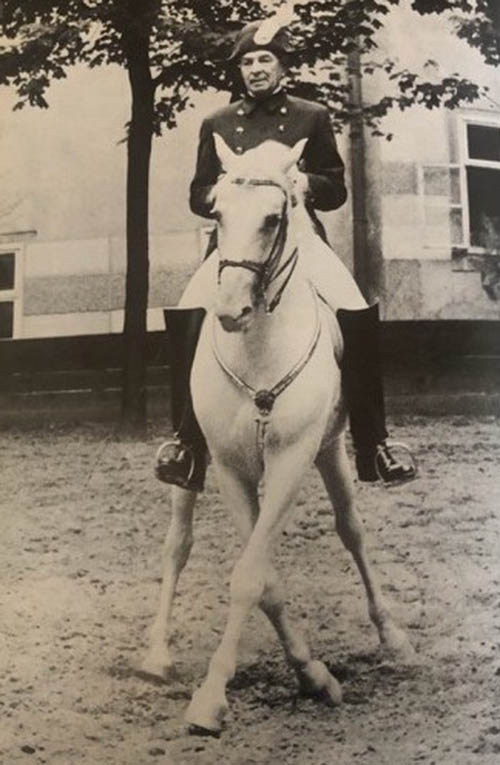
The half-pass done well is a beautiful expression of this training. The horse maintains balance while gracefully moving forwards and sideways with the bend in the direction of travel. The rhythm perfectly maintained will be evidence of the balance and suppleness that the well-trained horse has achieved. As the training of the horse advances, the steepness – or the amount of sideways travel – increases. Even in the Grand Prix this movement is considered so important that the half-passes are worth double marks.
Of course, we begin to train the lateral (sideways) movements with the leg-yield. The horse stays straight in his body or a little bent away from the direction of travel, the outside leg is applied behind the girth and he yields forwards and sideways. When he understands this, we ask for the shoulder-in, then travers and then renvers, where we ask for bending and sideways movement but keep him travelling along the wall to support him. Always we want him to accept the outside rein, and be soft on the inside rein. We do not pull his nose in the direction of travel to make the bend. If we did that we would lose the possibility for suppleness. It is always important that the shoulders are leading so that the inside hind leg is still pushing under the body of the horse to give power and true collection.
Many horses will have achieved the necessary balance and suppleness to perform a shallow half-pass by the time they are six years old and starting to do the work in the Medium level tests. So, from then on the focus of training the half-pass is to improve the quality. A quality half-pass will be supple, flowing, rhythmical, each step the same with lovely crossing of the legs and a sense of riding uphill, forwards and across.
I am going to outline a number of training exercises that you can use to develop the suppleness and balance of your horse so that he slowly becomes able to obediently do a steeper and more cadenced and more beautiful half-pass.
FIRST COMES THE RHYTHM
Always remember that rhythm is the first thing on the Training Scale. Rhythm, suppleness, contact, impulsion, straightness and collection are the qualities on the Training Scale which we must observe if we are to increase the quality. If he loses rhythm he is letting you know that he is losing balance and you may need to restore the quality of the pace.
1. Half-pass to shoulder-in and back to half-pass. When you are doing the half-pass and you notice he is losing suppleness (bend or rhythm), just keep pushing him with your inside leg into the outside rein and make a shoulder-in that is parallel to the long side whenever you need to restore the balance. Then back into your half-pass. You may do this three or four times in a long, gentle half-pass on the long diagonal, e.g. FXH or KXM.
2. Shoulder-in to the end of the long side, keep the bend into a very small half circle (try 8 metres), take him sideways into a steep and very bent leg-yield to establish the legs crossing. Then allow him more forward on a less steep diagonal line, but gently flip the bend. His legs still keep crossing but he makes half-pass. An important principle of training is to make the right thing easy, so making the leg-yield very steeply sideways and the half-pass more shallow encourages him.
3. Transitions in the half-pass really help him improve his balance. You keep the half-pass line but start with small transitions in the half-pass. A few bigger steps, a few smaller steps. Of course, transitions within the pace are a really fundamental way to improve anything. We can never do too many transitions, no matter what we are training.

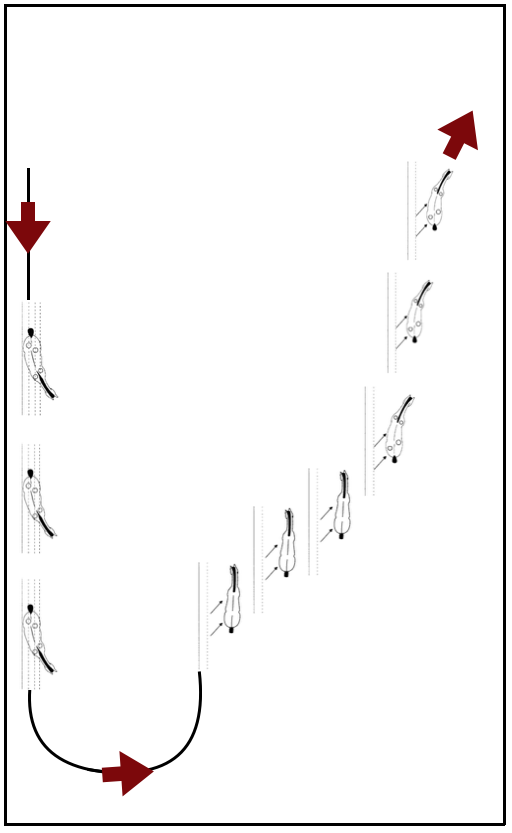
4. You can put a transition to walk and then back to trot within your half-pass line. This exercise of coming to walk for a few steps within a half-pass is great to help him balance. When riding these transitions, think about keeping the shoulder and withers up as you do the transitions. The transition will not do its job of training if you allow him to fall onto the forehand as he makes the transition to walk.
5. Use the travers to help him become supple. Establish the bend you want in the corner, or using a small circle, and lead him into the travers. He must look straight ahead along the long side and bend around the inside leg. Your outside rein supports him to keep his shoulders on the wall. Your shoulders should be parallel to his shoulders, and you look up the long side. Your hips must be parallel to his hips, so your inside hip comes forwards. Establish the travers and make it steeper, a bigger angle to the wall. This exercise will help him learn to balance in a steeper half-pass, e.g. more sideways.
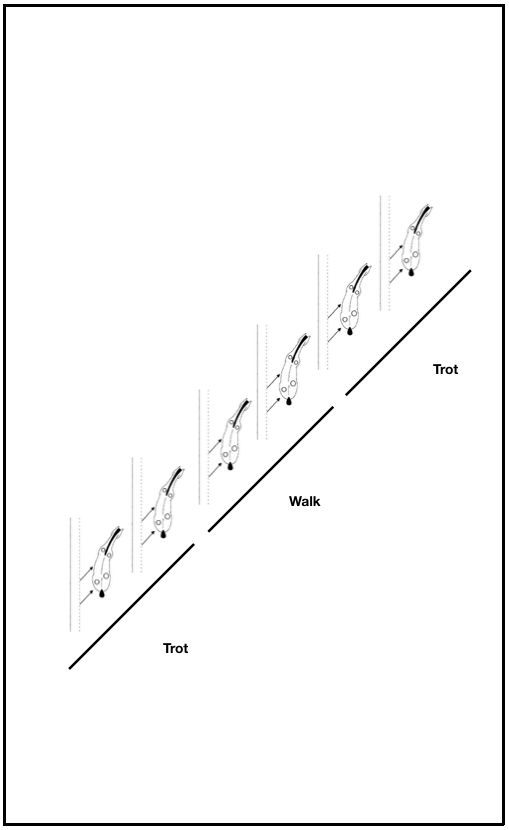
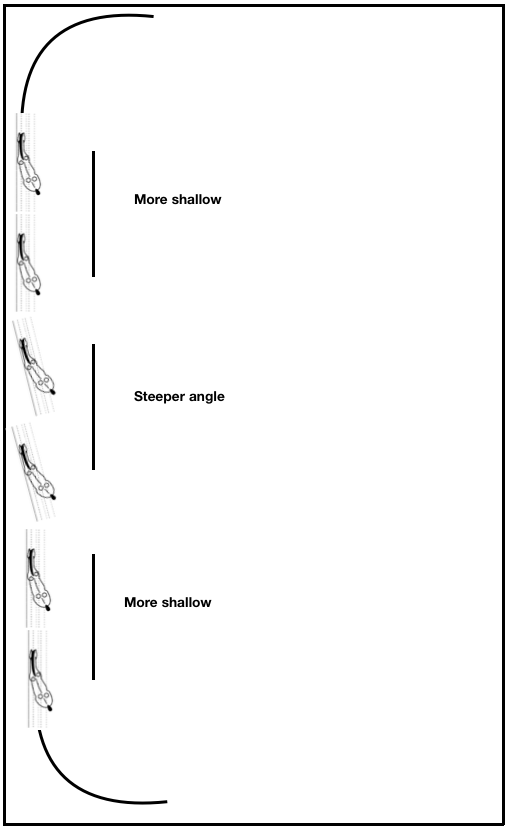
6. To help him learn to keep energy in the half-pass, ride a diagonal line in medium trot and put the half-pass in the middle half, e.g. ride medium trot for enough sets to establish the lengthened strides, bend him into a half-pass on the line you have for about half the distance, and finish the diagonal line in the medium trot. This helps him think forwards in the half-pass.
7. Use a big circle to train the suppleness with travers. Training a movement on a circle has the great advantage that a circle has no beginning or end, so you can begin and finish anywhere. The circle will help you keep the bending. Establish the quality of your trot in a circle, hold the shoulder on the circle with your outside rein and push the hindquarter in with your outside leg. Your inside leg, as always in these exercises, is like a post that you bend your horse’s body around.
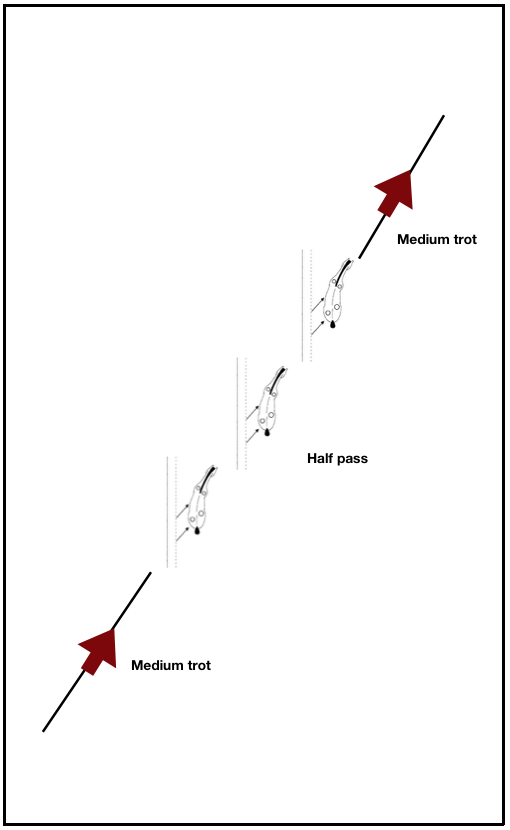
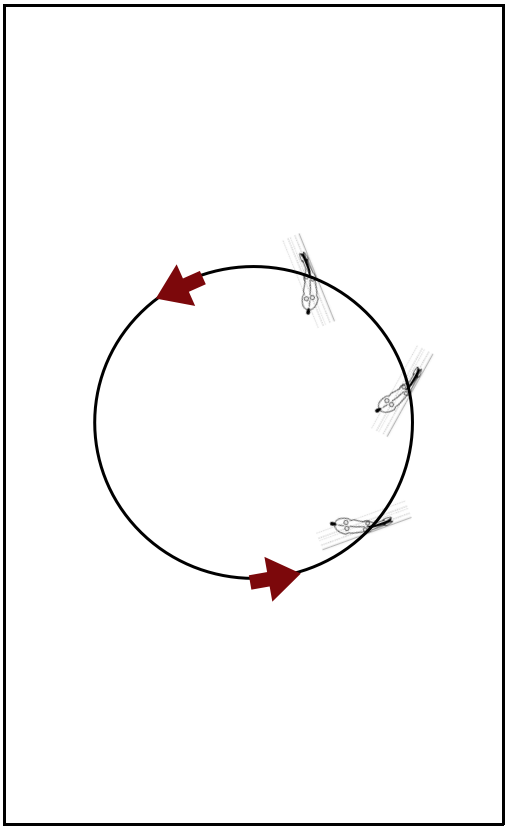
8. On the circle you can alternate from shoulder-in to get him traveling from your inside leg to outside rein and then into the travers to build suppleness and obedience. Establish the circle with bend. Turn the shoulders into the circle; try to use your outside rein to do this. Inside leg keeps him bending and supple and keeps the circle big. Try to soften your inside rein to test self-carriage.
9. The ultimate exercise to improve the cadence and expression in the half-pass is to ride transitions in and out of passage in the trot half-pass. Establish the half-pass in trot and then ride the passage into the trot, keeping the half-pass line. You increase the cadence, then try to keep the rhythm and energy that he has offered in the passage half-pass steps as you allow him back into a lovely expressive trot. You do not want these passagey steps in the test, but it does help to use it to train. In the test, if he is running or falling in the half-pass, a half-halt with the outside rein can help him rebalance with a reaction like the reaction you have trained in this exercise. Of course, he must know the passage quite well before you can use this as an exercise.
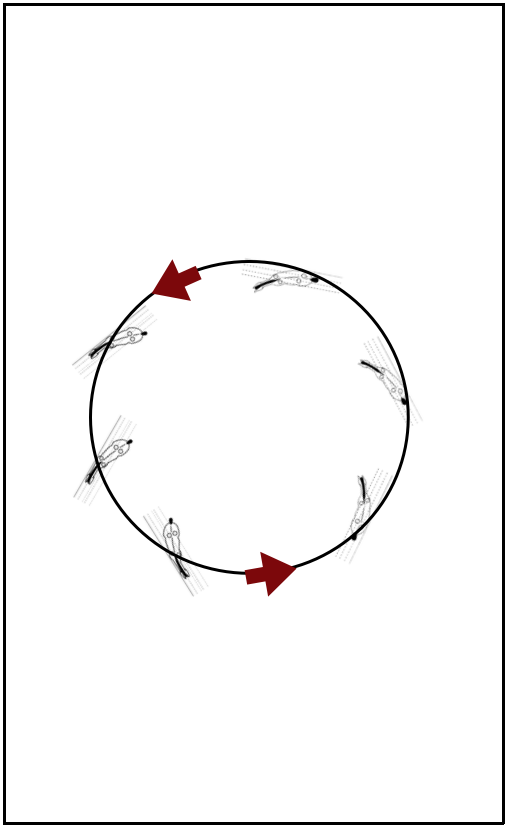
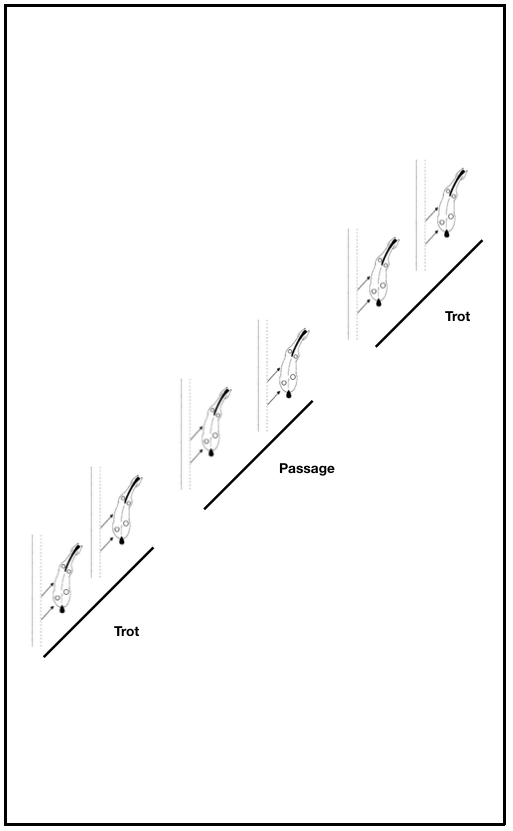
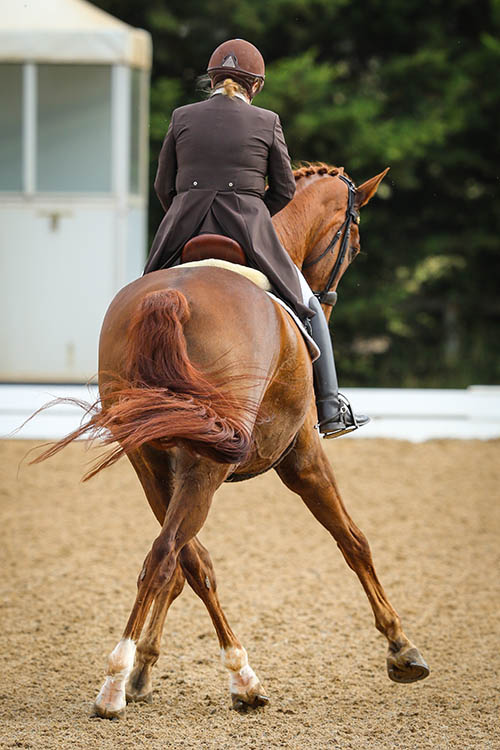
PREPARE PROPERLY
To ride your best half-pass in the ring, first prepare by making your best engaged, rhythmical trot. Use the short side to rebalance the trot. Use the corner to help get collection and bending. Prepare him for the half-pass by doing a couple of steps of shoulder-in with the angle you want in your half-pass. Just before the marker that the half-pass starts at, turn his nose towards the marker you are going to. Take the shoulders off the track towards the marker (the shoulders will be in front where you need them if you have used the shoulder-in to prepare). Then bring the hindquarter with your outside leg.
This way the shoulders will always lead, as they must in a correct half-pass. Look at the marker you are going to, and your shoulders face the marker. Your hips stay square to where you want his hips. Ideally your outside rein holds his outside shoulder to the outside, like a travers on the diagonal line and preventing him from falling in the direction he is going. Your inside leg is like the post that he bends around, and the inside leg keeps him travelling forwards. The outside leg controls the sideways flow. You can also take the outside rein to help him go less forwards and so more sideways. Try to be on the correct diagonal even at the sitting trot. As his outside shoulder goes forwards in the trot, your seat lightens imperceptibly. This will help your aids have the correct timing. Your legs will wrap around him a little as his inside hind leg is reaching forward.
So, enjoy the training. It doesn’t have to be boring and repetitive if you use a variety of different exercises to help him become the best athlete he can be. Have fun. EQ
READ MORE BY DR KERRY MACK:
Learn From Your Mistakes – Equestrian Life, March 2022 issue
Young Horse Classes: A Fun Launching Pad – Equestrian Life, February 2022 issue
Making Sense of all the Bits & Pieces – Equestrian Life, January 2022 issue
The Secret to ‘Soft Hands‘ – Equestrian Life, December 2021 issue
Ask Less, Reward More – Equestrian Life, October 2021 issue
So You Want To Go To The Games? – Equestrian Life, September 2021 issue
The Ins & Outs Of Bitless Bridles – Equestrian Life, July 2021 issue
Taking The Plunge With The Lunge – Equestrian Life, June 2021 issue
Dressage for Showjumpers – Equestrian Life, May 2021 issue
23 Shoulder-In Exercises to Improve Your Horse – Equestrian Life, April 2021 issue
Understanding Your Horse’s Inner Thoughts – Equestrian Life, March 2021 issue
Make the Most of Your Seniority – Equestrian Life, February 2021 issue
Building Better Relationships – Equestrian Life, January 2021 issue
Whipping Up Controversy – Equestrian Life, December 2020 issue
The Importance of a Trusting Relationship – Equestrian Life, November 2020 issue
Welcome to Kindergarten for Foals – Equestrian Life, October 2020 issue
The Carrot or the Liquorice? Positive Reinforcement – Equestrian Life, September 2020 issue
Submission or Stress? Something to Chew On – Equestrian Life, August 2020 issue
A Relaxed Horse is a Happy Horse – Equestrian Life, July 2020 issue
The Literate Horse Rider – Equestrian Life, June 2020 issue
Why Horses Love Ingrid Klimke – Equestrian Life, May 2020 issue

